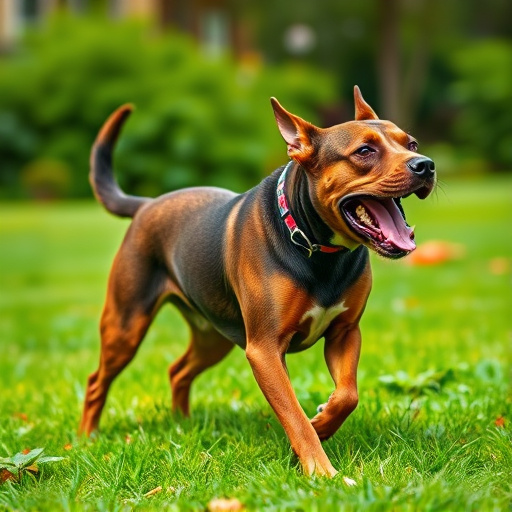Understanding aggressive dog behavior is crucial for management. Factors like fear, anxiety, breed instincts, lack of socialization, and health issues contribute. Safety measures include child-proof locks, training, and using dog spray for protection. When employing dog spray, prioritize child safety with adjustable nozzles, mist settings, and child-proof locks. Proper usage involves holding the spray 3-4 feet away from the dog's face and eyes for 2-3 seconds while wearing protective gear. Store sprays securely to prevent accidental misuse.
“Protecting yourself and your family from aggressive dog encounters is crucial, especially with children in the home. This comprehensive guide delves into the world of pepper spray as a potential solution for dog aggression, offering a powerful yet strategic tool for self-defense. From understanding the behavior behind the bite to selecting the right spray and learning safe application methods, this article equips readers with knowledge to ensure peace of mind and child safety first. Discover how simple precautions and the right gear can transform your family’s security.”
- Understanding Aggressive Dog Behavior: Causes and Triggers
- Child Safety First: Evaluating Risk and Precautions
- Choosing the Right Pepper Spray for Dogs: Features and Benefits
- Effective Application Techniques and Safety Measures
Understanding Aggressive Dog Behavior: Causes and Triggers
Aggressive dog behavior can stem from a variety of causes and triggers, making it crucial to understand these factors for effective management. One of the primary reasons behind aggression is fear or anxiety. Dogs with traumatic pasts, such as those that have been abused or neglected, may react aggressively when they perceive a threat to their safety or well-being. Even seemingly harmless situations like unfamiliar surroundings or loud noises can set off an aggressive response in dogs suffering from anxiety disorders.
Additionally, certain breeds are predisposed to aggression due to their natural instincts and heritage. For instance, some terrier breeds were originally bred for hunting and may have a strong prey drive that can lead to unprovoked attacks on other animals or even humans. Lack of proper socialization during puppyhood can also contribute to aggressive tendencies later in life, as these dogs might not know how to interact appropriately with people or other pets. Moreover, health issues like pain or discomfort from an injury can make a dog more irritable and prone to lashing out. Ensuring child-proof locks on doors and windows, proper training, and the use of dog spray for protection during problematic interactions are essential steps in managing and mitigating aggressive dog behavior.
Child Safety First: Evaluating Risk and Precautions
When considering pepper spray for aggressive dogs, child safety should always be the top priority. Before deploying any protective measures, it’s crucial to evaluate potential risks and take necessary precautions around children. Since pepper spray can be unpredictable, especially in indoor spaces with poor ventilation, ensuring your home is child-proofed is essential. This includes installing child-proof locks on cabinets and doors where spray or other chemicals are stored.
Additionally, educating kids about the presence of such deterrents and setting clear rules about touching or interacting with them is vital. Always keep pepper spray out of reach of children and ensure they understand its purpose as a last resort for handling aggressive dogs, not as a toy or curiosity. Regularly review safety protocols to create a secure environment where both pets and kids can coexist harmoniously.
Choosing the Right Pepper Spray for Dogs: Features and Benefits
When considering pepper spray for aggressive dogs, it’s crucial to choose a product designed specifically for canine use. Look for features like adjustable nozzle and mist settings, ensuring the spray can be targeted precisely without causing unnecessary harm or distress. Child-proof locks are also essential for safety, preventing accidental deployment.
Benefits of such dog spray include its non-lethal nature, allowing for de-escalation rather than severe injury. The immediate sting and temporary blindness from pepper spray can help control an aggressive dog’s behavior while providing time for a safe resolution. Additionally, the scent remains on the dog, acting as a deterrent against future aggression, promoting long-term protection.
Effective Application Techniques and Safety Measures
When using pepper spray on aggressive dogs, proper application techniques are crucial for effectiveness and safety. Ensure you hold the can at the correct distance, typically 3-4 feet away from the dog, and aim for the face and eyes. A quick burst of 2-3 seconds is usually sufficient to disrupt the dog’s behavior without causing long-term harm. Always remember to child-proof locks on spray cans to prevent accidental discharge.
Safety measures are paramount when handling pepper spray. Wear protective clothing, including gloves and safety goggles, to minimize exposure to the spray. Keep a safe distance from other people, especially children, during application. After use, thoroughly wash your hands and face with soap and water. Store pepper spray out of reach of children and pets, in a secure, well-ventilated area, to ensure both protection for your family and prevention of accidental misuse.
When all else fails, pepper spray for aggressive dogs can be a powerful tool for protecting your family. By understanding dog behavior, prioritizing child safety, and selecting the right spray with effective application techniques, you can create a safer environment. Remember that prevention through training and behavioral modification remains key, but having child-proof locks and dog spray protection as a backup plan is crucial for peace of mind.
